Over the past month, we’ve been publishing a series of blogs called Who You Know In Action—a look at a subset of innovative organizations that are specifically designed to broker deep and diverse relationships in young people’s lives to expand access networks of support and opportunity. Based on those case studies, we wanted to understand broader efforts afoot to build students’ social capital.
To that end, this spring, we administered a brief online survey to 160 organizations who serve young people ages 14 to 24 across the country. Our list of organizations drew from a snowball sampling effort that we undertook last fall to identify programs and tools specifically aimed at helping young people to form new relationships that offer support and/or open doors to opportunity. 96 organizations responded to the survey. The data below offers a snapshot of what these organizations shared about their approaches to brokering and supporting relationships in the lives of the young people they serve.
Because this is by no means a nationally representative sample, the data is best seen as a starting point to form hypotheses about the potential of, and gaps in, growing efforts to expand young people’s stock of social capital. The following takeaways illustrate patterns, challenges, and opportunities when it comes to how programs are putting more and stronger relationships within reach for young people.
Our top 10 takeaways
1. Organizations are primarily focused on traditionally underserved populations. There is slim but troubling data that access to relationships—particularly networks into the knowledge economy—are not equal along dimensions like race and class. The majority of respondents reported that they primarily serve low-income (77%) and/or minority youth (71%).
2. Programs and tools are putting a range of types of relationships in reach. Different relationships can offer different benefits in students’ lives, and developmental research points to the power of a web of supportive relationships—rather than a single caring tie—in helping young people to thrive both developmentally and in their careers. Respondents were asked to identify all types of relationships they put within reach for young people. These included a wide range of relationship types, but the most common relationships reported included Adult mentors (74%), Peer cohorts (65%), and Industry mentors (62%).

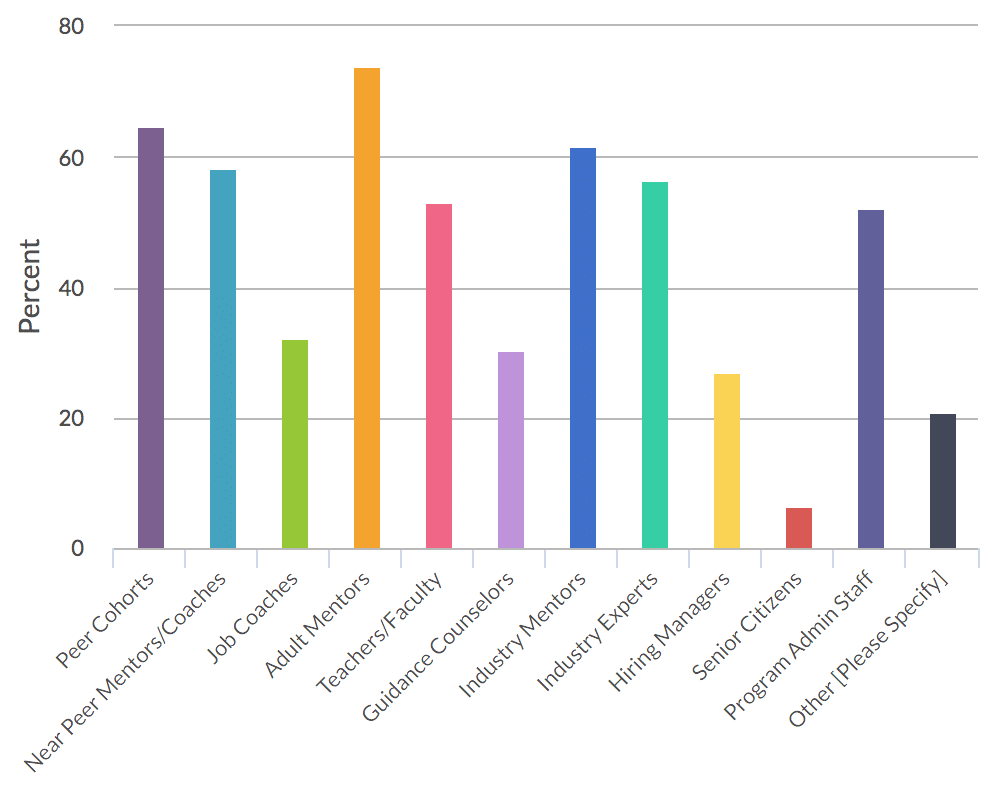
3. Both strong and weak ties are part of most programmatic designs. Given the research that both strong (close ties whome they know well) and weak (briefer connectinos and acquaintances) ties can offer real (albeit different) benefits, we asked organizations to report the relative strengths of the different relationships they were brokering for young people. Almost all organizations (97%) reported at least one strong or medium-strength tie, and strong ties were almost always accompanied by additional weaker (medium or weak) ties. The most common strong ties reported were with Teachers (80%), Peers (71%), Program admin staff (62%), and Adult mentors (60%). The most common weak ties reported were with Hiring managers (50%), Industry experts (47%), and Industry mentors (24%). Although strong ties were more common, consistent with research on the so-called “strength of weak ties,” the types of weak ties reported (hiring managers, industry experts, industry mentors) are those with potentially high payoff for access to new information or job opportunities.
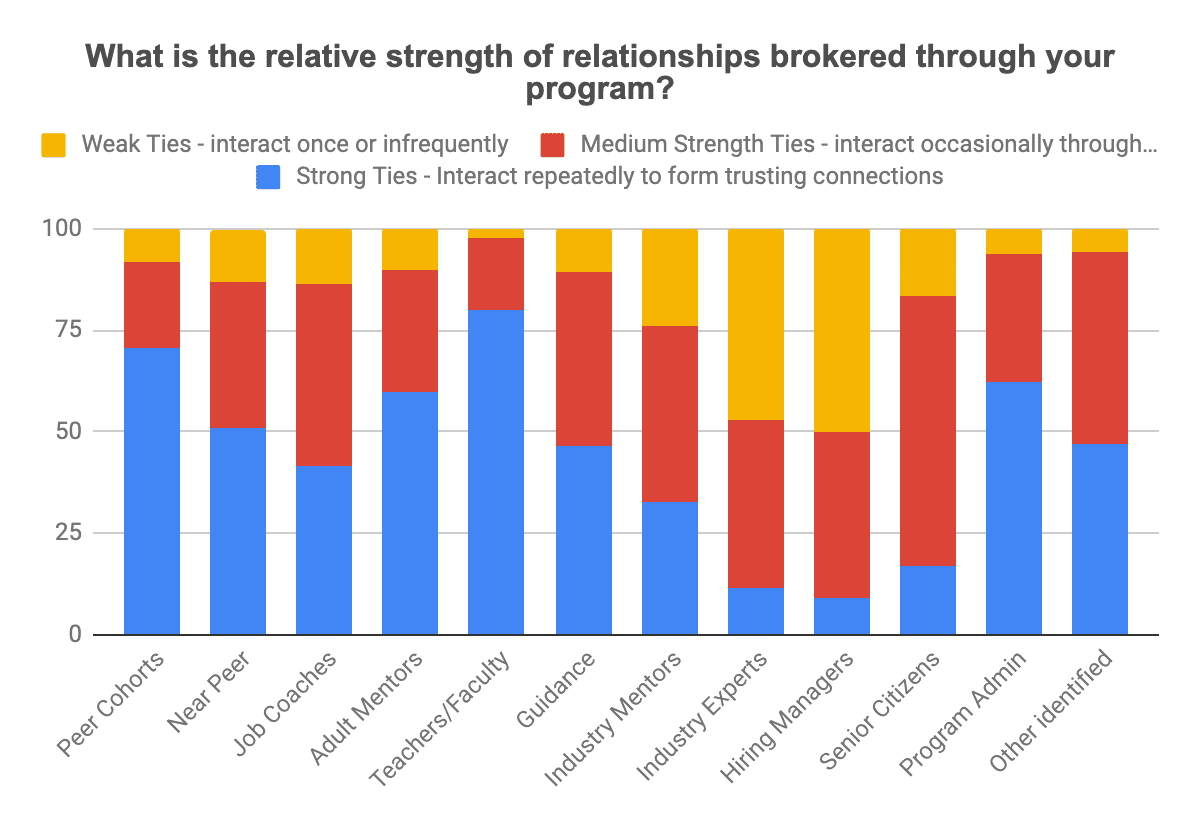
4. Most organizations reported using homegrown curriculum to teach networking and relationship-building. While all of the programs surveyed were putting relationships within reach for young people, many are also aiming to teach students the skills and dispositions to forge and mobilize positive relationships. The vast majority of respondents (89%) reported that they aim to teach networking and relationship-building as part of their program. Of those who do provide lessons on networking and relationship building, the majority (85%) reported that they created relationship-building curriculum and lessons in-house.
5. Most organizations use technology to connect program participants. In 2019, young people are constantly maintaining—and in some cases forging—relationships across an array of communications media and technology platforms. Programs are likewise leveraging tech to connect with students. Organizations collectively listed 26 different platforms for connecting participants to peer or adult networks. The most common technologies used for maintaining relationships were: Phone calls (71%), Text messaging (64%), and Google Suite (49%). Although less than half of programs reported using LinkedIn as part of their own program infrastructure, half of programs reported either requiring or encouraging participants to create their own LinkedIn profiles in the course of their program.

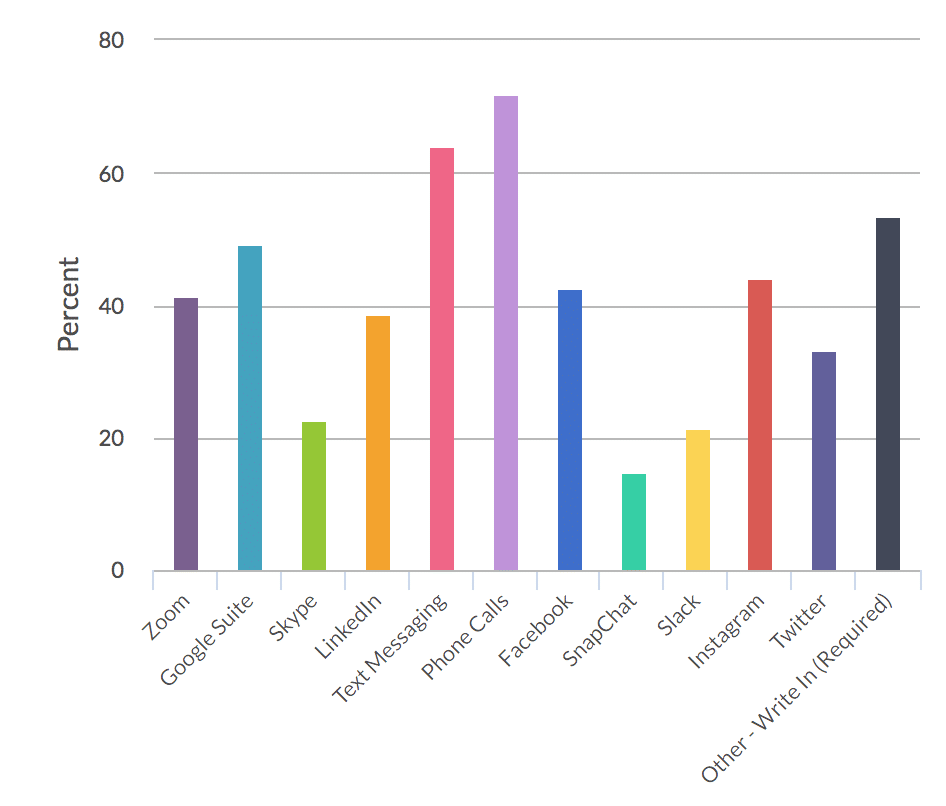
6. Organizations tended to use multiple technology-based tools at once in order to maintain relationships. Given the wide array of affordable communications tools on the market today, it’s safe to say that no one tool rules them all. Organizations reported using a wide variety to build and maintain connections between participants and adults. Of 77 organizations who reported using technology tools to maintain relationships with participants, 65 organizations (84%) reported using 3 or more tools. Twenty-eight organizations (36%) reported using 7 or more tools to maintain relationships.
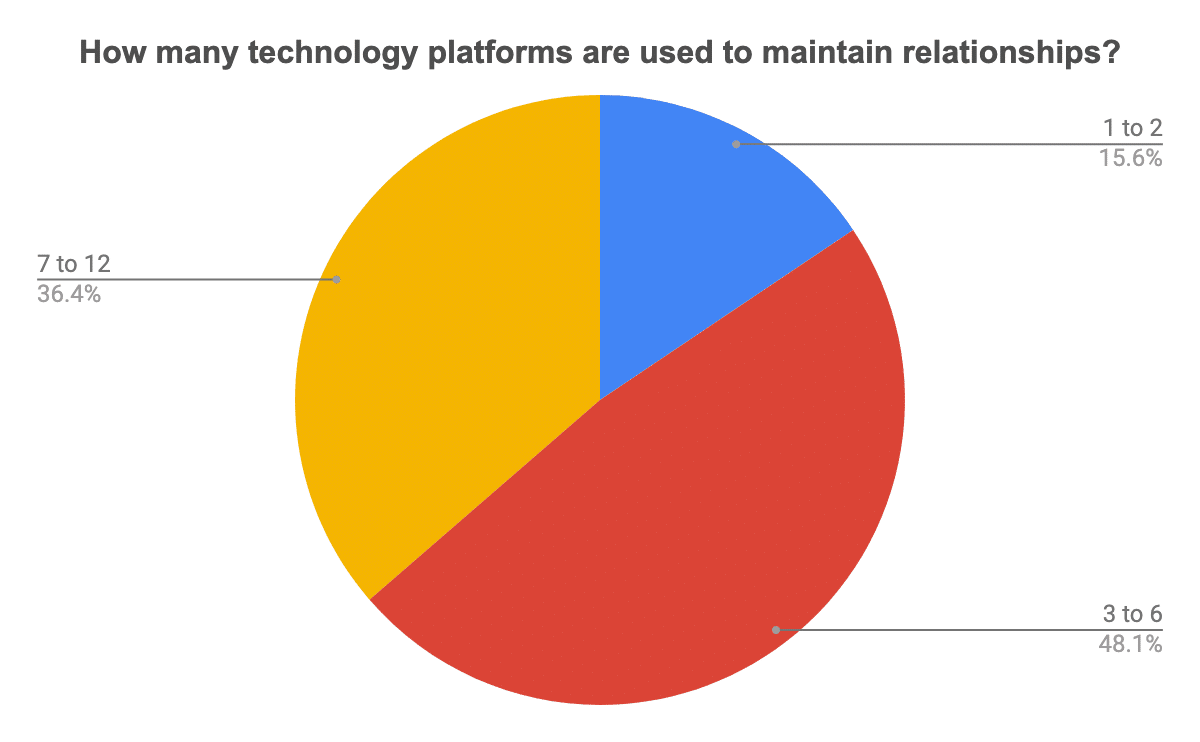
7. Approximately half of all organizations surveyed (45%) measure growth over time of young people’s networks created in the course of their programming. As the saying goes, ‘what gets measured gets done.’ Although all of the organizations in our sample had a clear focus on putting relationships within reach, approximately half had integrated the growth of those relationships into their measurement and internal quality assurance processes. Efforts to measure network growth as an outcome rather than just input to learning and development offer one indication that programs are focusing on creating lasting social capital assets for young people.
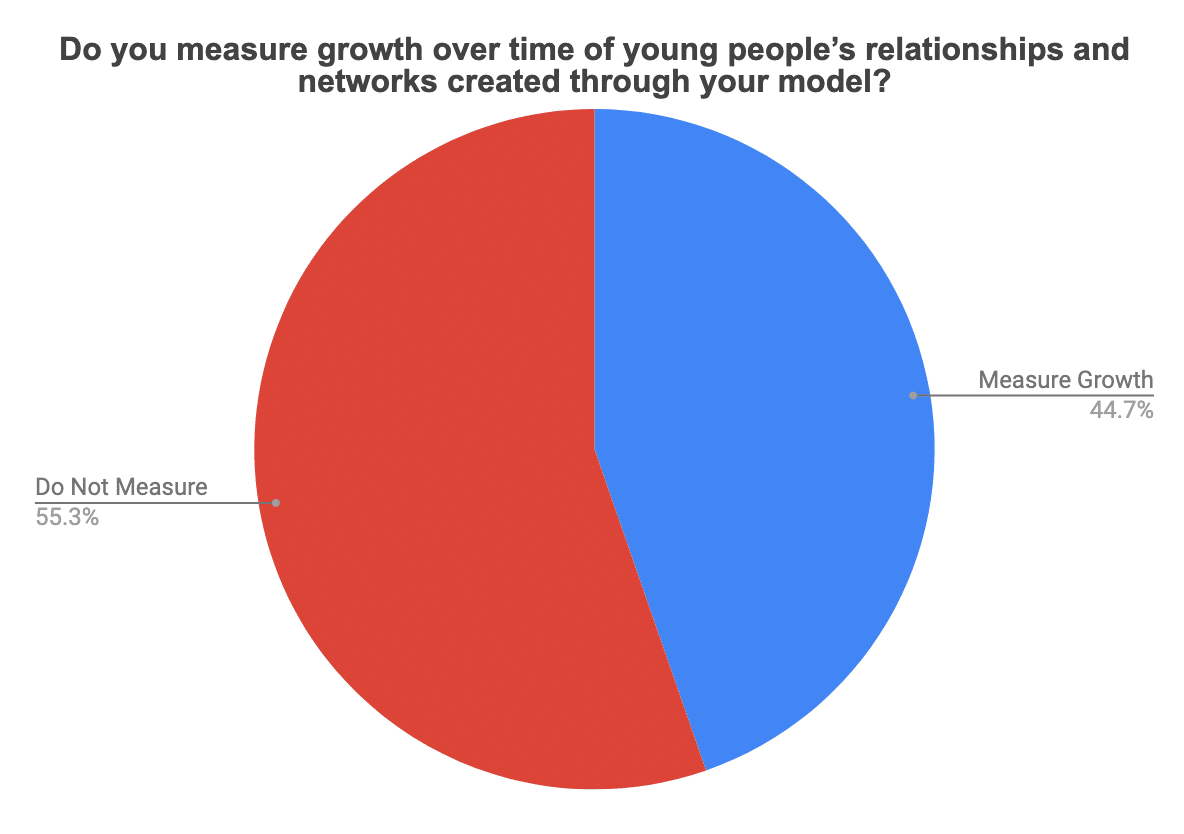
8. Of those who measure relationship growth over time, the tools and methods they used varied widely. Measuring students’ access to networks and the quality of ties within those networks is still an emerging practice with few to no agreed upon measures. Some indicators that programs used as proxies for relationship growth and quality included tracking the number of touch points between students and mentors or other relationships, self-report surveys in which young people report the helpfulness of, or level of, trust they maintain with their mentor, and staff observations of virtual meetings.
9. Organizations reported that the greatest challenges they faced when it came to investing in relationships were keeping track of the relationships they brokered and measuring the quality of relationships. Despite widespread agreement that “relationships matter,” tracking and measuring them remains difficult. Fifty percent of organizations surveyed responded that “Measuring the quality of relationships” is a challenge. Approximately half of the organizations surveyed (47%) report that “Keeping track of relationships brokered in our program” is a challenge. The tools organizations currently use for tracking relationships are extremely wide-ranging. Thirteen organizations use third-party platforms, but there is no overlap between any of the platforms different organizations use. In other words, there is no tool that any two of the organizations surveyed use.

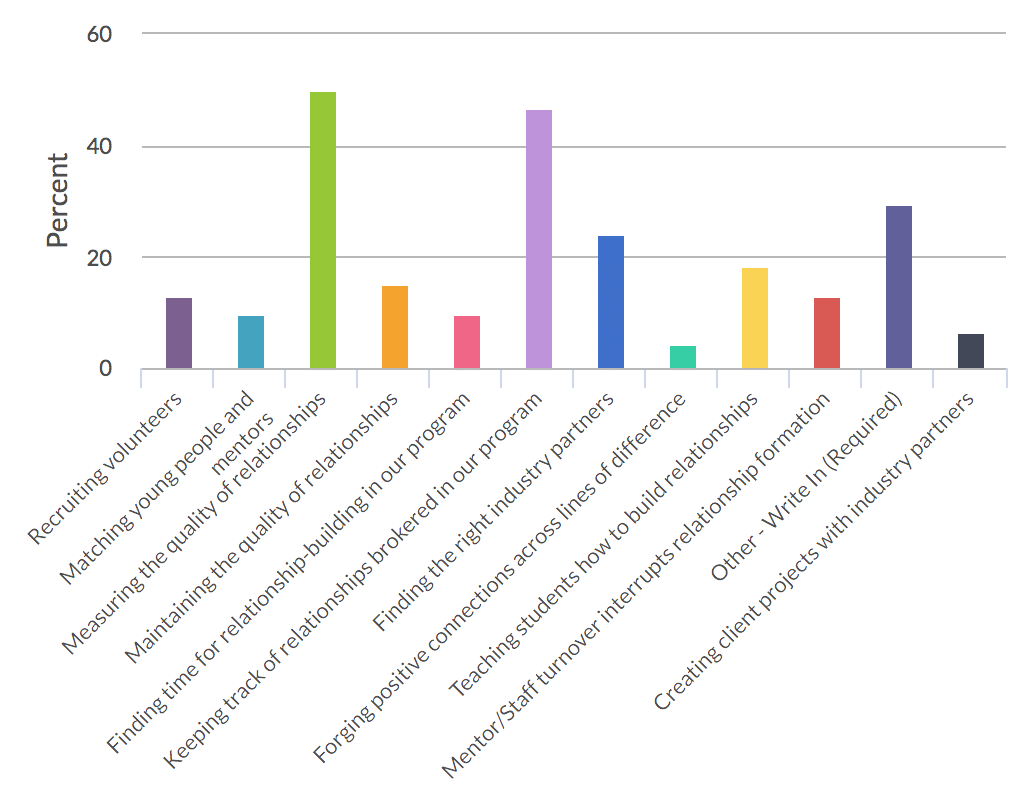
10. A subset of organizations reported building their own platforms to track relationships. Much like curriculum and lessons on relationship-building, organizations are creating their own solutions to the challenges above. Of 41 organizations that said they were currently tracking relationships, 22 (54%) shared that they have built their own measurement tools, and nine additional organizations (22%) stated that they are currently building their own tools.
Looking ahead: Designs and tools to support relationship-building
Relationships are critical assets to getting by and getting ahead. Especially for institutions aiming to tackle opportunity gaps, ensuring that students have access to deep and diverse connections is critical. Although this survey by no means captured a representative sample, it did reveal some patterns and potential gaps worthy of further exploration.
For example, there’s a clear appetite emerging for tools for measuring the quality of relationships and tools for tracking relationships. There also may be an untapped market for common, off-the-shelf relationship-building curricula or lessons that could support programs currently resorting to homegrown solutions.
The abundance of technology tools in use offers a mixed blessing that merits further exploration as well: the more platforms and technologies programs adopt, the harder it may be for them to track interactions across an array of tools. Analyzing the specific technologies that organizations prefer for different types of connections and which technologies work best together could help streamline technology solutions to how programs fuel their work at brokering connections, communicating with students, tracking relationships at play, and even measuring the quality of those relationships over time.
Is your tool or program facing or tackling challenges like these? If so please share your approach in the comments!



